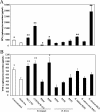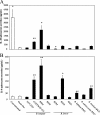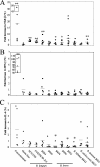Gnotobiotic mouse immune response induced by Bifidobacterium sp. strains isolated from infants
- PMID: 18083875
- PMCID: PMC2227707
- DOI: 10.1128/AEM.01261-07
Gnotobiotic mouse immune response induced by Bifidobacterium sp. strains isolated from infants
Erratum in
- Appl Environ Microbiol. 2008 Aug;74(15):4982
Abstract
Bifidobacterium, which is a dominant genus in infants' fecal flora and can be used as a probiotic, has shown beneficial effects in various pathologies, including allergic diseases, but its role in immunity has so far been little known. Numerous studies have shown the crucial role of the initial intestinal colonization in the development of the intestinal immune system, and bifidobacteria could play a major role in this process. For a better understanding of the effect of Bifidobacterium on the immune system, we aimed at determining the impact of Bifidobacterium on the T-helper 1 (T(H)1)/T(H)2 balance by using gnotobiotic mice. Germfree mice were inoculated with Bifidobacterium longum NCC2705, whose genome is sequenced, and with nine Bifidobacterium strains isolated from infants' fecal flora. Five days after inoculation, mice were killed. Transforming growth factor beta1 (TGF-beta1), interleukin-4 (IL-4), IL-10, and gamma interferon (IFN-gamma) gene expressions in the ileum and IFN-gamma, tumor necrosis factor alpha (TNF-alpha), IL-10, IL-4, and IL-5 secretions by splenocytes cultivated for 48 h with concanavalin A were quantified. Two Bifidobacterium species had no effect (B. adolescentis) or little effect (B. breve) on the immune system. Bifidobacterium bifidum, Bifidobacterium dentium, and one B. longum strain induced T(H)1 and T(H)2 cytokines at the systemic and intestinal levels. One B. longum strain induced a T(H)2 orientation with high levels of IL-4 and IL-10, both secreted by splenocytes, and of TGF-beta gene expression in the ileum. The other two strains induced T(H)1 orientations with high levels of IFN-gamma and TNF-alpha splenocyte secretions. Bifidobacterium's capacity to stimulate immunity is species specific, but its influence on the orientation of the immune system is strain specific.
Figures



References
-
- Amrouche, T., Y. Boutin, G. Prioult, and I. Fliss. 2006. Effects of bifidobacterial cytoplasm, cell wall and exopolysaccharide on mouse lymphocyte proliferation and cytokine production. Int. Dairy J. 16:70-80.
-
- Bjorksten, B. 2004. Effects of intestinal microflora and the environment on the development of asthma and allergy. Springer Semin. Immunopathol. 25:257-270. - PubMed
-
- Bjorksten, B. 2005. Evidence of probiotics in prevention of allergy and asthma. Curr. Drug Targets Inflamm. Allergy 4:599-604. - PubMed
-
- Bjorksten, B., P. Naaber, E. Sepp, and M. Mikelsaar. 1999. The intestinal microflora in allergic Estonian and Swedish 2-year-old children. Clin. Exp. Allergy 29:342-346. - PubMed
-
- Boyle, R. J., and M. L. Tang. 2006. The role of probiotics in the management of allergic disease. Clin. Exp. Allergy 36:568-576. - PubMed
Publication types
MeSH terms
Substances
LinkOut - more resources
Full Text Sources
Other Literature Sources

